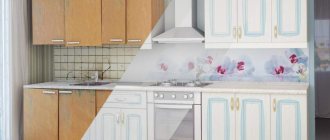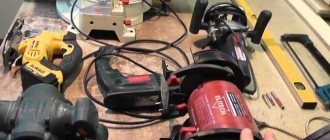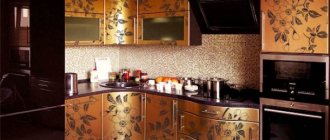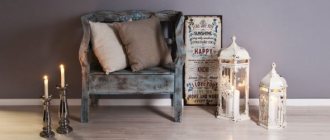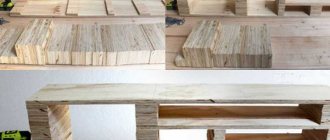It would seem that insignificant details often determine whether the furniture will be comfortable and durable or not. Choosing and installing the right legs for a kitchen unit is not as easy as it seems at first glance. Delving deeper into this question, it turns out that they are very different from each other: high and low, adjustable and not, plastic and metal... So which are better, and are they needed at all?
Advantages and disadvantages
There are no advantages without disadvantages, but kitchen legs have many more advantages than disadvantages.
The positive points include:
- aesthetic appearance. Furniture with legs looks lighter and airier. This point is especially important in small kitchens;
- extra space. It is very convenient to store bulky items under the kitchen unit: building materials left over after renovation (cuts of skirting boards, profile pipes), skis, etc. The main thing is to push items away so as not to spoil the appearance of the kitchen;
- headset protection. Legs save the lower cabinets and their contents in case of a flood. In most cases, supports are made of materials inert to water (plastic, metal). Therefore, when flooding occurs, only the flooring suffers, and not the furniture;
- ease of adjustment. During installation, height-adjustable legs make it very convenient to level the tabletop. With their help, you can smooth out differences caused by floor defects;
- free access to communications;
- additional ventilation. It is especially important if the kitchen has built-in appliances;
- Possibility to fix the plinth . The presence of legs allows you to remove and install the base if necessary. With its help you can change the appearance of the kitchen.
There are significantly fewer negative aspects. The main disadvantages can be considered:
- difficulties with cleaning. You can only get rid of dust and dirt around each support manually, which is tiring. But if this is not done, cobwebs and debris peeking out from under the headset will spoil the appearance of the interior;
- objects rolling into the gap between the set and the floor. During the cooking process, any fallen round-shaped vegetable (onions, potatoes, etc.) will certainly end up under the kitchen cabinets. If there are animals or small children in the house, there will be many times more unnecessary items under the set. Without noticing in time an apple that has rolled under the cupboard, after a while you can find a lump of rot and mold there;
- higher cost. No, standard plastic supports are relatively inexpensive, but they do not have a very aesthetic appearance. They are usually hidden by additionally installing a base. Designer legs made of metal or wood cost many times more.
Most manufacturers of high-quality furniture make it with legs. Only budget models of headsets of not very high quality are produced on a non-removable base (a box made of MDF or chipboard). Such a support swells very quickly from moisture and loses its appearance. Even the silicone base covers (covers) that are sold to protect the box do not help.
Why do you need adjustable legs in the kitchen?
The reason for purchasing adjustable legs for a set is most often uneven floors in the kitchen. A big advantage of the design is the ability to install the headset level and so that it does not wobble.
In second place, the reason for the purchase is the height of the lower cabinets that does not meet the requirements. In standard kitchen sets, the height of the floor cabinet is about 90 cm. The calculation includes the thickness of the kitchen countertop, the height of the body and legs. This size is designed for the average height of a woman (165 - 175 cm), in order to make her cooking activities as convenient as possible. These dimensions also correspond to household appliances, which are often built into kitchen cabinets.
Growth may exceed standard calculations. Being behind a low surface for a long time, as a result, the user will begin to experience constant back pain due to the load on the spine. Also, due to the discrepancy in size, your hands will also suffer from fatigue. Adjusting the legs helps avoid these problems by raising the cabinets higher.
| Tip: For people who are short, the lower limit of the cabinets should correspond to the height of the built-in appliances (dishwashers and washing machines). |
And, of course, modern design style also plays an important role in the use of adjustable legs. Many consumers really like it when the working surface of a kitchen set is divided into parts of different heights.
In the video, why do you need adjustable legs in the kitchen:
Varieties
The range of supports for kitchen units is very large. You can choose the right size, shape and color to suit any kitchen style. At the same time, kitchen legs can be distinguished according to several parameters.
Form
Modern designers offer an almost endless number of possible options: from the banal to the most non-standard. Conventional cylindrical supports are considered classics, but in addition to them there are:
- cubic;
- triangular;
- legs of irregular shape;
- trapezoidal;
- spherical;
- wavy;
- ovoid.
When choosing the shape of the legs for the set, you need to take into account the supports of the rest of the kitchen furniture. Manufacturers often produce components for tables, chairs, sofas, etc. in one collection. A single style of supports will be very beneficial to unite all the elements of furniture, making the interior whole and complete.
Types of furniture legs are not limited to the above options, but other types are practically not used for kitchen sets. The same wheeled models often cannot withstand the load, so they are used only in isolated cases.
Supports, legs for furniture
Material
Any of the forms can be embodied in various materials. The most common types:
- plastic. Quite a common material (due to its low cost). Both very simple models are produced (they are usually hidden behind the plinth), as well as more original designs “like wood” or “chrome”;
- from natural wood. They are rarely found on the open market due to their relatively high cost (the price of the simplest wooden legs starts at 500 rubles per unit, while a budget plastic support will be ten times cheaper). Usually they are made to order, complete with a similar set made of natural wood;
- metal. The most popular option. Most often they are made of aluminum, steel or their alloys. A huge selection of shapes and sizes allows you to choose an interesting option for almost any interior. But metal legs for lower cabinets look best in modern styles (modern, hi-tech, minimalism, etc.). As for the cost, it can vary greatly depending on the production method. Metal supports can be: pipe;
- cast;
- stamped;
- combined. Most often they combine metal with plastic, much less often with wood. In most cases, such models are made adjustable (the plastic knob is unscrewed with a screw).
Often, in order to reduce the cost of the headset, designer metal legs are installed only on the front (visible) part. Hidden supports are replaced with inexpensive plastic analogues. On a volumetric headset, using such a substitution you can save several thousand.
Dimensions. Adjustable and non-adjustable
Depending on the material and manufacturer, the supports are adjustable or non-adjustable. The latter are much more convenient; they allow you to change the height of furniture legs by a distance of 20 to 40 mm (depending on the manufacturer). This is very convenient if the floor covering has differences. With this adjustment, it is easy to level the countertop and cabinets, regardless of the slope of the floor.
Non-adjustable are available in three standard sizes:
- 10 cm;
- 12 cm;
- 15 cm.
If the floor is flat, then in most cases this set of values is sufficient. Plinth strips are produced to suit every standard height. But if there are unevenness and differences in the floor, it is better to give preference to adjustable kitchen supports.
Some models of plastic legs can be cut to the desired height. Theoretically, it is possible to trim supports made of solid wood or aluminum, but the final version in this case does not always look aesthetically pleasing.
Also, the legs can vary greatly in diameter or thickness. This point is also important. The thinner the support, the greater the load will fall on the point of contact between the support and the “floor” of the headset. If the lower base is made of not very strong materials, it may bend at the attachment points under the weight of the kitchen cabinets.
Color
Classic options are: black and metallic shades. Chrome legs come in matte and glossy finishes. In addition, they can imitate various metals with their shades. They come in colors like bronze, gold, silver, etc.
Solid wood supports are usually tinted to match the color of the set, in some cases they are made to contrast in tone with other finishing elements.
The choice of shades for plastic products is limited; usually they are only black, white or brown. This is due to the fact that in most cases they are hidden behind the base, or placed on the side of the rear (hidden) wall.
Types of supports for kitchen furniture
Furniture legs must be of high quality, as they take on the entire load of the set.
The main purpose of the legs is to protect any furniture from penetration of moisture from the floor and, accordingly, its destruction. And the created air gap between the floor and the bottom of the furniture elements prevents this. For beauty, the resulting gap between the floor and the bottom of the furniture can be closed from the outside with a false panel in a color matched to the main color of the furniture. The legs play an important role, bearing virtually the entire load of the furniture structure.
Functions of furniture legs:
- Decorative. The entire set of furniture legs must match the overall design of the entire kitchen.
- Power. They are the support of the entire furniture structure. They support and balance the weight of furniture cabinets and items placed in them. And if you install them in a kitchen sofa, then so does the weight of the person sitting on them.
Furniture legs can be installed on any element of the kitchen set. They are produced in any shape, size, color range and in terms of design they are:
- wheeled;
- adjustable;
- furniture rollers;
- screw type;
- static.
Static type legs are used mainly in the production of upholstered furniture and economy class kitchen sets.
Roller feet can be used where only forward movement of the furniture is required.
Roller supports are used where only linear (not requiring the object to turn when moving) movement of furniture elements is necessary and are made in the form of a U-shaped frame with a wheel mounted on it on the transverse axis.
Conventional adjustable supports are a standard screw with a plastic knob mounted on it (so that when moving an object it does not damage the floor covering) and a counter part, which is a nut with eyes welded to it for fastening to the bottom of the cabinet. Height adjustment is made by screwing in a screw. The disadvantage of this design is the need to unload the cabinet before adjustment. When adjusting, you have to constantly raise its angle in order to set the correct height, and this can be physically difficult and requires two people to do it (one lifts, the other adjusts at the same time).
How to choose?
The main job of kitchen legs is to support the weight of lower cabinets and their contents. Therefore, the main selection criterion should be the reliability and strength of the support. Flimsy models with thin walls can shorten the life of the headset.
When purchasing kitchen legs, they must be checked for defects. There should be no cracks or places with thin soft metal or plastic (the wood is usually solid, so such problems arise less often with it). If the product can be bent by hand, it is unreliable.
Depending on the width of the supported module, a different number of supports are required:
- two. Suitable for narrow cabinets up to 20 cm wide;
- four. The most common option. Suitable for modules up to 80–90 cm wide. The maximum width depends on the depth of the cabinet and the expected load;
- six . Installed on large cabinets with a width of more than 90 cm.
As for the height of the supports, there are no strict regulations, rather wishes.
In kitchens with low ceilings, a set with high legs looks disproportionate. But when choosing the height of the supports, you must first focus on your own height.
It will be inconvenient for a tall person to cook on a low countertop, just as it will be inconvenient for a short person to cook on an excessively high one. Choosing the wrong height can lead to back problems.
Article on the topic: Height of kitchen tables with countertops. Optimal and standard sizes
If you don’t know exactly what height is needed, it’s better to give preference to adjustable legs. In most cases, a travel reserve of 20–40 mm is enough to adjust the overall height of the cabinet.
Dimensions
In addition to shape and material, the legs vary in size. This parameter is one of the most important, since the permissible load on the furniture depends on it. There are three main groups - low products, medium and high. The choice of the appropriate option will depend on the type of furniture:
- Low size group - used in cabinets, kitchen sets, coffee tables. The height of the legs is 50–60 mm.
- Medium - 65–90 mm, suitable for shelves and chests of drawers.
- High - 90–850 mm. Such supports are usually mounted on tables.
The degree of adjustment is determined by the size group. For example, legs with a height of 100 to 120 mm vary within 10 mm. From 150 to 180 - up to 20 mm. The maximum range - 30 mm - is typical for legs with a height of 200 mm.
In terms of changes in diameter, an adjustable furniture leg does not differ from standard supports. This parameter varies from 45 to 145 mm in increments of 5 (45, 50, 55 and so on). The widest products are used for large cabinets.
The standards also define the ratio of height and diameter. Typically, the lower the support, the smaller its diameter. However, the size chart is wider than the basic parameters, so almost any furniture store offers an impressive assortment of this fittings.
Reasons for the popularity of roller shutters for wardrobes, their types
The degree of height adjustment of the legs is determined by the size group
Low
Average
High
How to screw it to furniture?
Various manufacturers literally compete in a variety of shapes and designs. But when choosing a non-standard solution, you should remember that the method of fastening will depend on the shape of the legs. Conventionally, all installation options can be divided into three types:
- standard. The most common installation method. Four fixation points (holes for fastening) are evenly distributed around the support;
- screw. Found near cylindrical and spherical supports. B with a thread that screws into the cabinet. The support has no other fixation points. Some models are supplied with a counter nut to screw the leg to the kitchen cabinet through the “floor”;
- non-standard. Models of non-standard shape are attached in this way. The installation option and the number of fixation points depend on the type of specific support. So, triangular legs have three fastening points, etc.
Most ready-made sets that only require self-assembly (from Ikea, etc.) have counters - small diameter holes in the places where the legs are supposed to be installed.
Screw-in legs are installed directly into the countersinks. Other models of supports are fixed so that this hole coincides with the center of the leg.
If the furniture was made to order, and there are no mounting holes for supports in the bottom cover, then you need to choose at what distance to attach the legs of the kitchen set based on three simple rules:
- the distance from the edges should be at least 5–8 cm;
- intermediate legs (if they are necessary) are attached under the transverse jumper (in the absence of one, in the center);
- on the side of the facade, the indentation should be such that the legs (or base) do not interfere with approaching the cabinets. The distance must be selected with special care if you have a dishwasher. If the indentation is incorrect, the plinth may subsequently interfere with opening the dishwasher door.
Next, on the bottom cover, markings are made for the legs in the form of crosses (the intersection of the lines should coincide with the center of the support). If there will be a lot of supports, it makes sense to make a template through which it will be convenient to put marks and make holes. In this case, you need to ensure that all supporting elements are at the same distance from the edge.
If the legs are fixed using self-tapping screws, then the length of the fastener should be 3 mm shorter than the thickness of the bottom cover. So, in order to properly screw the legs to a base 18 mm thick, you need 15 mm self-tapping screws.
⚫ How to screw LEGS TO KITCHEN CABINETS
Installation and adjustment
When installing adjustable legs yourself, it is important to focus on the furniture parameters. First you need to measure its actual height, then decide how many centimeters you want to raise or lower it. If necessary, you can use the recommended standards:
- It is better to place the sink one meter from the floor - with this placement it is most comfortable for a person to use it.
- Work and other kitchen surfaces are raised to a height of 85 cm.
- Oversized wardrobes rise 190–210 cm above the floor surface.
Variety of handles for kitchen furniture, the best manufacturers
The most difficult thing is to make the correct markings. A cross is formed at the corners; for this, a distance of 50 mm is taken from each side. Usually the leg has several holes for fastening - central and side. The first one needs to be aligned with the crosshairs, the center of the others should be marked with a pencil, then pricked with an awl. Now you can put the leg back on and secure it with self-tapping screws. Then the height is set - using a screwdriver, screw in the screw until the desired level is reached. There are configurations that are easy to set manually. It is more convenient to mount if you first unscrew the leg and then reassemble it. If you don’t want to waste time on this, you can use a magnetic holder that will help you handle the assembled support.
50 mm is the standard size, from which there may be deviations. In the kitchen, it is often determined by the location of household appliances - for example, a dishwasher under the countertop can limit the permissible depth of the supports.
In addition to proper installation, it is necessary to monitor the supports during use. It is important to observe the maximum permissible load and avoid moving loaded furniture. Wooden legs require special care, and metal elements can easily damage the flooring if handled carelessly.
In addition to materials and shapes, it is important to choose the right size. The legs must be suitable for the height of the furniture, its weight and the planned load. When choosing, you also need to pay attention to the quality of the fittings and the possibility of replacing them. In order for the product to last a long time and ensure ease of use of the furniture, it is necessary to provide for all these points.
It is better to place a cabinet with a sink at a height of one meter from the floor
The kitchen set is usually raised to a height of 85 cm
The optimal height for sliding wardrobes is 190–210 cm from the floor
In order for the product to last a long time, it is important not to exceed the permissible load and avoid moving loaded furniture
The legs must be suitable for the furniture in terms of height, weight and planned load.
How to adjust the height of the supports?
When installing the headset on adjustable legs, problems with adjustment usually do not arise. The height of the supports can be changed using a special screw thread.
With the help of adjustment, three issues can be solved at once:
- level the tabletop;
- distribute the weight of the kitchen cabinets evenly between all supporting elements;
- adjust the height of the tabletop in accordance with the height of the residents of the house.
Typically, the supports are adjusted during the initial assembly of furniture. If adjustments are needed during operation, the cabinets must be completely unloaded before adjustment.
You can change the height of non-adjustable legs only by cutting them, or, on the contrary, by placing something under the supports. Both methods cannot be called successful, but in some cases this is the only available solution.
Adjustable Kitchen Supports for Kitchen Tables
Figure 2. Plastic legs are the most budget-friendly support option.
Another important function of adjustable legs for kitchen furniture is their use to set the required height of the kitchen table in order to hide any unevenness in the floor. The most common option is to install a chrome support with a screw-in plastic tip. It allows you to adjust the table height within a range of up to 4 cm.
The reverse side of the chrome leg is attached to the tabletop from the inside with self-tapping screws. The advantages of a chrome table support are that it can withstand quite significant loads, the stylish appearance of chrome, which allows the table to fit harmoniously into almost all styles used to create kitchen designs.
When purchasing furniture for the kitchen, pay attention not only to its main parameters, but also do not forget about the little things.
For example, take care of the ability to adjust kitchen items in height. After all, any, even the most insignificant detail, can greatly overshadow the joy of the purchase and will constantly remind you of itself. This could be hitting your knees on the bottom of the table, an aching back after working in the kitchen, or the inability to pour a full pot of water due to the horizontal skew of the countertop.
Be careful, and then the purchased item will please you for a long time and will not cause any inconvenience.
Do I need to cover the legs, and with what?
Beautiful designer legs are usually left open. They are initially selected to match the rest of the kitchen interior.
There are many advantages to this solution:
- lighter and airier look of the headset;
- availability of additional space for storing bulky items (narrow and long);
- additional ventilation (good air flow is especially important if there are built-in appliances).
Despite the large number of advantages, kitchens without a plinth on legs are not very common. This is due to a fairly large number of associated disadvantages:
- something is constantly being rolled under the set with open legs (food during the cooking process, children's toys, all sorts of little things);
- Thoroughly cleaning the space under kitchen cabinets with legs can only be done manually, and dust and dirt “peeping out” from under the furniture spoil the interior;
- higher price. Even the smallest set requires at least a dozen supporting elements. For large U-shaped or island kitchens you may need forty or fifty of them. Beautiful designer legs are usually quite expensive, and budget plastic ones don’t look very interesting.
Most often they are hidden by standard plastic supports. There are three ways to hide them:
- behind the plinth . This option is the most popular. The planks are produced from a variety of materials (plastic, MDF, aluminum chipboard, etc.) in various colors. In addition to decoration, the base can perform many additional functions: protect the space under the headset from dust and moisture (for this, a special silicone seal is placed on it);
- be an additional lighting element (for illumination, spotlights can be embedded in it, or an LED strip can be attached);
- be a functional part of the set (additional drawers are built into the base, thereby increasing the amount of usable space);
- behind the curtain. Curtains instead of kitchen facades are also not very common, but are still found in retro-style kitchens. This drapery successfully hides not only the shelves of the cabinets, but also the lower supports. In addition to the non-standard design, this solution helps to significantly save on facades and fittings, which do not need to be screwed to the kitchen cabinet.
Whether the bottom should be covered is a moot point. After all, both options have both advantages and disadvantages. Therefore, this decision is made for each case separately, taking into account all the features of the interior.
How to attach the plinth to the legs?
Special mounting clips are sold for mounting the base. They consist of two parts: one half is mounted on the protective strip, and the second is fixed on the leg.
It is most convenient to install clips on the most common plastic supports. In most cases, such supporting elements are sold immediately complete with fasteners for the base.
It is also possible to attach the base to metal or solid legs. But you will have to buy the clip separately, matching it to the shape and diameter of a particular model.
The bar is not attached to all supports of the headset. If kitchen cabinets are less than one and a half meters long, then two fixation points at the edges of the module are sufficient. Longer plinths require an additional attachment point closer to the middle of the strip.
The installation process of the support clip does not require any special skills. Marks are placed on the strip at the locations where the fasteners are installed. The clips are screwed to the bar using short self-tapping screws with flat heads (so that they do not penetrate through the base and interfere with the clip).
The second part of the clip is fixed to the kitchen support. In this case, you need to ensure that both parts of the fastener are at the same level.
It is quite easy to snap the base into place, but if you are not used to it, it may not work the first time. There is no need to worry about this; just a few attempts and attaching the base will seem like an elementary procedure.
For rooms of non-standard design, bent strips and special connectors have been developed. They allow you to assemble a plinth for L-shaped or trapezoidal kitchens.
Photo gallery
Did you like the article? Tell your friends about it:
- 1
- 1
- 1



